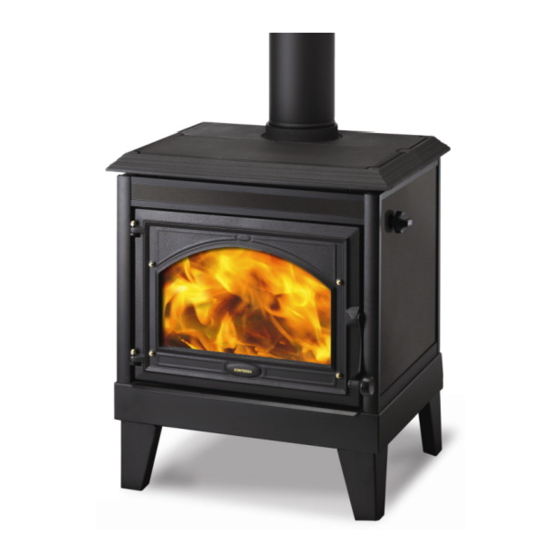Firenzo CONTESSA Gebruiksaanwijzing - Pagina 8
Blader online of download pdf Gebruiksaanwijzing voor {categorie_naam} Firenzo CONTESSA. Firenzo CONTESSA 9 pagina's. Freestanding clean air woodburner
Ook voor Firenzo CONTESSA: Handmatig (10 pagina's), Instructies voor installatiehandleiding (8 pagina's), Installatie- en bedieningshandleiding (17 pagina's)

CO Alarm
Your installer should have fitted a CO alarm in the same room as the appliance. If the alarm sounds
unexpectedly, follow the instructions given under "Warning Note" above.
8.4 Extractor fan
There must not be an extractor fan fitted in the same room as the stove as this can cause the stove to emit
smoke and fumes into the room.
8.5 Permanent air vent
If the stove requires a permanent and adequate air supply in order for it to operate safely and efficiently.
In accordance with current Building Regulations the installer may have fitted a permanent air supply vent into the
room in which the stove is installed to provide combustion air. This air vent should not under any circumstances
be shut off or sealed.
8.6 Chimney cleaning
The chimney should be swept at least twice a year. It is important that the flue connection and chimney are swept
prior to lighting up after a prolonged shutdown period.
If the stove is fitted in place of an open fire then the chimney will require sweeping after a month of continuous
operation. This is a precaution to ensure that any "softer" deposits left from the open fire usage have not been
loosened by the higher flue temperatures generated by the closed stove.
8.7 Periods of prolonged non-use
If the stove is to be left unused for a prolonged period of time then it should be given a thorough clean to remove
ash and unburned fuel residues. To enable a good flow of air through the appliance to reduce condensation and
subsequent damage, leave the air controls fully open.
8.8 Use of fireguard
When using the stove in situations where children, aged and/or infirm persons are present a fireguard must be
used to prevent accidental contact with the stove. The fireguard should be manufactured in accordance with BS
8423:2002 (Replaces BS 6539).
8.9 Aerosol sprays
Do not use an aerosol spray on or near the stove when it is alight.
9.0 Routine stove maintenance
9.1 External maintenance
9.1.1 Cast iron surfaces
Cast iron is a live material. There are no two ovens that are identical. This is partly due to the tolerances of the
casting process, partly because the stoves are a work of craftsmanship.
The cast surfaces of the stove are painted with high temperature Stovebright paint. It is best maintained by simply
vacuuming it with a soft brush attachment or wiping it down with a dry, dust-free cloth when cool.
If the stove is used too vigorously, the painted surface may assume a greyish tinge over time, but the stove can
easily be freshened up with high temperature Stovebright paint.
9.1.2 Painted Surfaces
Painted surfaces are coated with a specialist high temperature finish. To clean use a damp/dry cloth. Do not use
abrasive cleaners/materials that may cause scratching to the surface .
9.2 Internal maintenance
9.2.1 Glass window
If the stove is used correctly, very little or no soot will be deposited on the ceramic glass window. If soot does
form on the glass as the stove is being lit, it will burn away once normal combustion begins in the stove. If the
glass window becomes thoroughly covered in soot due to incorrect operation, the soot can be easily removed
using an approved glass cleaner. The glass must be cold when you clean it. Avoid stoking the stove with pieces
of wood that are so long that they press against the glass window when the door is closed.
9.2.2 Reasons for sooty glass window:
- The fuel is too wet.
- The pieces of fuel are to big/uncut wood.
CU-2013-05-14
8
